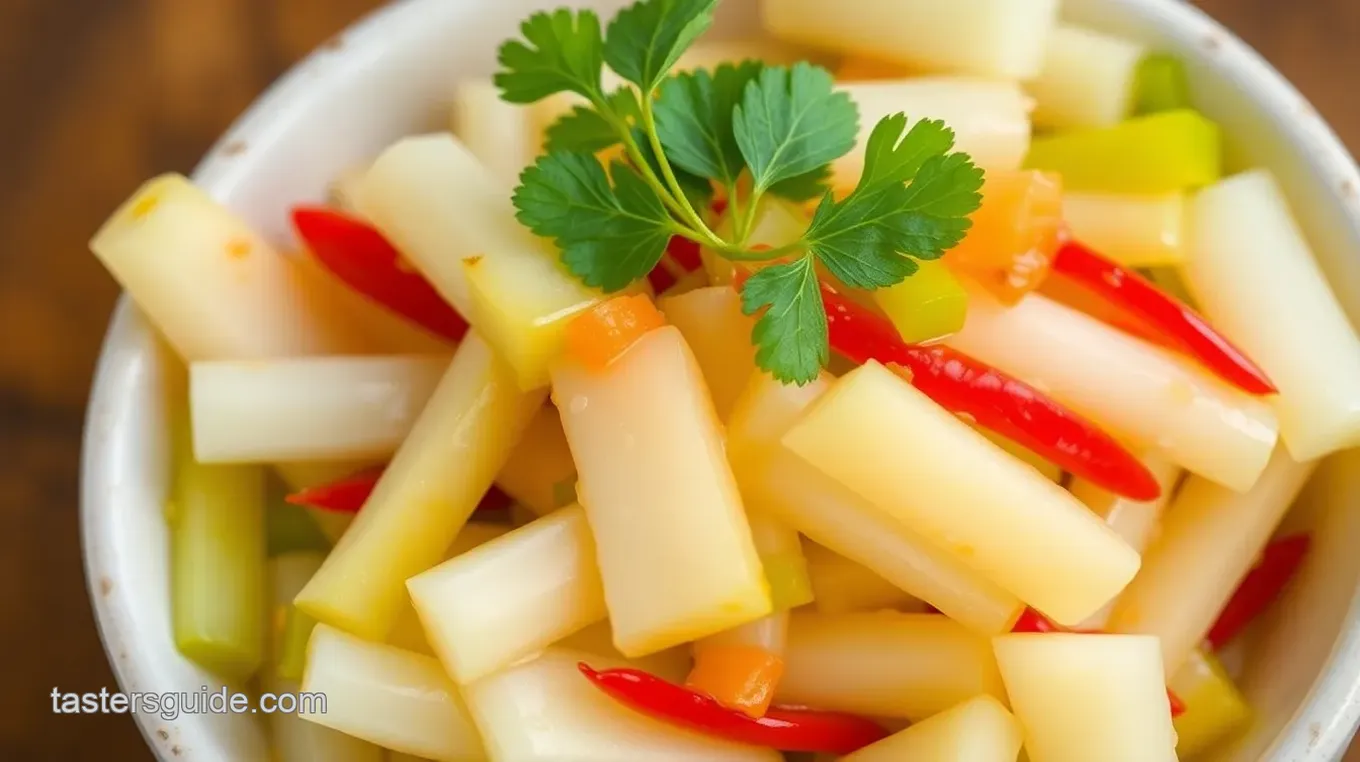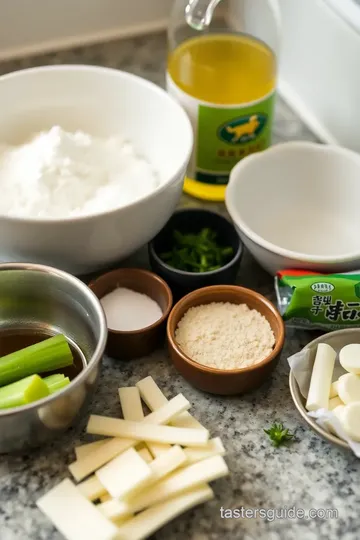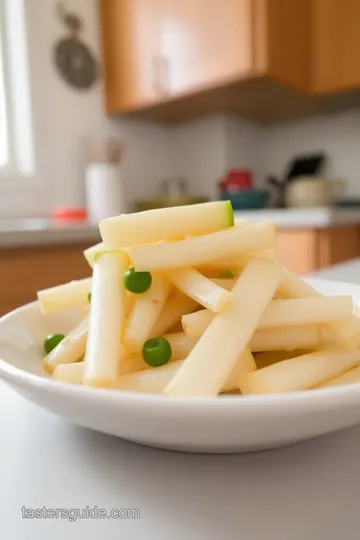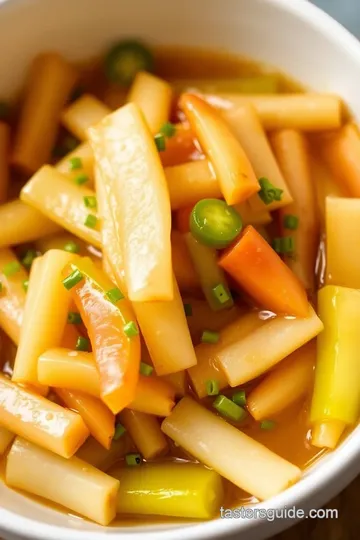Quick Korean Radish Pickles (Danmuji)
Looking for Quick Korean Radish Pickles for Joyful Meals? Discover my easy recipe for these tangy, crunchy delights that brighten any dish!

- Quick Korean Radish Pickles for Joyful Meals: A Tangy Delight
- Essential Ingredients Guide: Making Your Kitchen Exciting!
- Mastering the Art of Professional Cooking: Quick Korean Radish Pickles for Joyful Meals
- Pro Tips & Secrets
- Perfect Presentation
- Storage & Make-Ahead
- Creative Variations
- Complete Nutrition Guide
- Encouraging Conclusion
- Frequently Asked Questions
- Recipe Card
Quick Korean Radish Pickles for Joyful Meals: A Tangy Delight
Oh my gosh, have you ever bitten into a crunchy pickle and just felt instant happiness? i know i have! last summer, i visited a little korean diner in my neighborhood and ordered some bulgogi.
When those quick korean radish pickles —or as the cool kids call it, danmuji —landed on my table, i could hardly contain my excitement.
The burst of tangy, sweet flavors complemented the savory beef perfectly. that moment? pure joy!
Have you ever wondered how these little gems of joy came to be? they’ve existed for centuries in korean cuisine and stand at the heart of many family meals.
I can totally see why they’ve stuck around all this time! pickles are like the fun, colorful sidekick of any meal, and once you experience that crunch, you'll want it on your table every week.
Recipe Overview: Quick and Easy Side Dish
Now, let’s quickly chat about why these pickles are so popular today. easy pickle recipes like this one are a lifesaver for busy folks.
You can whip it up in about 15 minutes and kick back while they chill in the fridge. you don’t have to be a culinary wizard, either—this is about as simple as it gets.
No cooking involved! just grab a knife and that means even my not-so-cookin' friends can handle this.
Plus, with about 4 cups of pickles from one batch, you’ve got yourself a bang for your buck! you'll enjoy homemade pickles all week long without breaking the bank.
Quick pickles like these are not only budget-friendly but also give you a healthy meal accompaniment that spices up lunches and dinners.
Key Benefits: Why You'll Love These Pickles
Let’s get into the good stuff—the benefits. for one, these pickles are low in calories and high in flavor. a typical serving is only around 30 calories .
They pack crunch and tang, making them an excellent choice for those watching their waistlines. plus, they’re vegan side dishes that add color and excitement to any meal.
Seriously, if you're looking for a salad topping, you’ll want to try these.
Worried about trying something new for your next gathering? these tangy radish pickles are perfect for special occasions. whether you're having a bbq or planning a family dinner, they’ll have your guests talking.
And when you pair them with bulgogi or toss them into kimbap as kimbap ingredients , you create an unforgettable experience.
Meal Prep Ideas: Get Ready to Make These Lovely Pickles
And guess what? since these pickles are make-ahead pickles , they stay good in the fridge for up to two weeks .
That’s like a gift that keeps on giving! the more they sit in that tangy pickling brine, the more flavor they soak up—just a little reminder that patience is a virtue in cooking.
Feel free to play around with the recipe, too. be adventurous! want a little kick? toss in some red pepper flakes or sliced carrots.
Change the vinegar if you’re feeling funky; apple cider vinegar works great, too. with so many variations possible, you can make these a million ways.
So are you ready to dive into the world of Quick Korean Radish Pickles for Joyful Meals ? Trust me, you’re gonna want to!
Now, let’s gather the ingredients and get started on this delightful journey into pickling! 🎉

Essential Ingredients Guide: Making Your Kitchen Exciting!
Hey there, food lovers! let’s dive into the essentials of cooking with a focus on what makes your meals pop.
Trust me; the right ingredients can transform a good dish into a fantastic one. if you’re ready to elevate your cooking game, stick with me!
Premium Core Components
When it comes to acquiring premium core ingredients , there are a few things you gotta keep in mind.
-
Detailed Measurements : Always measure with precision —like 1 cup (240 ml) of rice vinegar or 1 teaspoon (5 g) of salt. It saves us from potential kitchen disasters, right?
-
Quality Indicators : Look for freshness when shopping. Crisp veggies, vibrant colors, and zero weird smells should be your goal. Nobody wants stale or wilty ingredients!
-
Storage guidelines : keep your pantry free from time bombs! know how to store those ingredients. for instance, pickles can chill in the fridge for weeks, but herbs? fresh ones last only a few days.
So plan ahead!
-
Freshness Tips : Always check the date! Fresh produce can also be revived—think soaking wilted herbs in water for a while. Life hack alert!
Signature Seasoning Blend
Now let’s get to the fun part: signature seasonings . Who doesn't love a punch of flavor?
-
Essential Spice Combinations : Think of spices like cumin, chili powder, and paprika. It’s a total flavor festival!
-
Herb Selections : Basil, thyme, and cilantro are your best friends. They bring freshness in every bite! Mix them up for tasty herbaceous vibes.
-
Flavor Enhancers : Don’t sleep on garlic or onion powders. Trust me; a sprinkle elevates your dish from “okay” to “wow!”
-
Regional Variations : Explore! Swap out spices to make it Asian, Mediterranean, or Mexican. The world is your spice rack!
Smart Substitutions
Sometimes things go wrong, or you run out of that special ingredient. No sweat! Here are some smart substitutions :
-
Common Alternatives : Out of rice vinegar? Apple cider vinegar works just fine.
-
Dietary Modifications : Vegan in the house? Swap honey for maple syrup or agave.
-
Emergency Replacements : You can even use lemon juice if you're in a crunch. Adapt and conquer!
-
Seasonal Options : When summer hits, think of using fresh tomatoes for sauces instead of canned.
Kitchen Equipment Essentials
You gotta have the right gear to make this cooking journey smooth. Here are the must-have tools :
-
Essential Tools : A sharp knife and a trusty cutting board are non-negotiable!
-
Alternative Equipment Options : No whisk? Grab a fork!
-
Preparation Tips : Always prep ingredients before starting to cook. It keeps your cooking flow smooth!
-
Storage Solutions : Invest in airtight containers. Seriously, you don’t want your quick pickles going bad on you!
Now, let’s shift gears a bit. if you're looking to brighten your meals, why not try quick korean radish pickles for joyful meals ? these little tangy wonders, known as danmuji, are perfect alongside a juicy bulgogi or tucked into kimbap.
They're quick, easy, and oh-so-satisfying. honestly, who doesn’t love a crunchy pickle with their meal? perfect for summer bbqs, or even just for snacking, they’ll keep your taste buds dancing.
Plus, they pair beautifully with just about anything, making them an easy side dish that's healthy too. So grab those ingredients, and let’s get you started on making some delightful pickled vegetables that will steal the show!

Mastering the Art of Professional Cooking: Quick Korean Radish Pickles for Joyful Meals
Cooking at home doesn’t have to feel like a daunting task. i promise you, with a few professional cooking methods and some quick tips, you're just a short time away from creating delicious dishes like quick korean radish pickles .
These tangy, crunchy goodies—known in korea as danmuji—are perfect for brightening up any meal, whether you're serving up some bulgogi or just want a little zing in your rice bowl.
Let’s dive into the nitty-gritty of preparing these vibrant pickles!
Essential Preparation Steps
Mise en place is your best buddy in any kitchen. it sounds fancy, but it just means getting everything ready before you start cooking.
Chop and measure out your ingredients (like that medium korean radish —about 1 lb, peeled and julienned) and combine them in bowls.
This keeps things neat and organized and saves you from a last-minute scramble when your water starts boiling!
Time management is also key. this recipe requires a 15-minute prep time and then 30 minutes of chilling in the fridge.
Make sure you keep an eye on the clock—there's nothing worse than forgetting your pickles while you're bingeing a show!
Organization helps, too. have all your tools on hand: a cutting board, a mixing bowl for the pickling brine , and an airtight container for storage.
You want your workflow to be smooth!
And don’t forget your safety considerations ! always use a sharp knife to slice that radish; a dull knife can lead to accidents.
And make sure to wash your hands and surfaces—sanitation is super important!
Step-by-Step Process
Let’s break it down!
-
Prepare the Radish : Peel and julienne your radish.
-
Make the Pickling Brine :
- In your mixing bowl, combine 1/4 cup rice vinegar , 1/4 cup sugar , 1/4 cup water , and 1 teaspoon salt . If you're feeling a little adventurous, add 1 teaspoon turmeric for that pop of yellow color.
- Whisk until everything is dissolved smoothly.
-
Combine : Now, toss the grated radish in your brine. Mix it up! If you like a little heat, throw in some red pepper flakes .
-
Chill : Transfer the mix into your airtight container. Let it chill in the fridge for at least 30 minutes so those flavors can meld beautifully.
-
Serve : Enjoy these crunchy delights with your favorite meals!
Pay attention to your temperatures : serving them cold enhances that tangy radish flavor. And remember, patience pays off when waiting for that first bite!
Expert Techniques
Now, let's get a bit more gourmet. for professional results, ensure you maintain timing precision —trust me, over-marinated pickles lose their crunch.
Aim for that sweet spot of 30- 60 minutes of refrigeration for delightful texture.
Here’s a critical step : keep your pickles submerged in the brine. if they’re floating, they won’t absorb that goodness as well.
A small plate or a jar filled with water can help keep them under.
For quality checkpoints , taste the brine before you add the radish to make sure it’s just how you like it. Adjust that sugar and salt to match your palette!
Oh, and if things go sideways—like if they're too tangy, just add a touch more sugar or water to balance them out. Simple fixes for memorable bites!
Success Strategies
Everyone makes mistakes! one common one is forgetting to prep enough pickling brine. you think you have enough, but suddenly, it feels like the radishes are crying out for a swim.
Always double-check your ratios to avoid pickle panic.
Want to ensure quality assurance ? wait until they're perfectly chilled before diving in. this gives the flavors time to really bloom! and if you’ve made too many (if that's even a thing), that’s where make-ahead options come into play.
These pickles last about two weeks in the fridge!
These quick korean radish pickles are not just an easy pickle recipe; they’re a must-have condiment for every table, especially in the summer.
They pair perfectly as a side dish for korean meals, making every bite feel like a tiny celebration. so why wait? get ready to enjoy a fresh, crunchy vegetable pickle right at home!
Now that you’ve conquered these delightful pickles, stick around for the next section, where we’ll delve into even more additional information to keep your culinary journey vibrant!

Pro Tips & Secrets
Cooking is all about those little secrets that turn a good dish into a great one. for my quick korean radish pickles for joyful meals , there are a few simple things i do to make them pop.
First off, don’t skip the marinating time ! even though they’re ready in about 45 minutes, if you let them chill longer—oh my gosh, the flavor is just amazing .
I usually make them the night before for meals the next day.
Also, here’s a time-saving trick : make a double batch! they can be a quick addition to your meals all week.
Take them to potlucks, or just keep some on hand for those nights when you want to add a little crunch.
Want to enhance those flavors? Try adding a splash of squid sauce —yeah, you heard that right! Just a smidgen can bring out the umami vibes.
And when it comes to serving, don't be shy about presentation. put those pickles in a cute dish, maybe toss a sprinkle of sesame seeds on top, and trust me, your guests will be impressed.
Perfect Presentation
Speaking of presentation, let’s chat about plating techniques . you want your pickled vegetables to pop, right? aim for a color burst! arrange those strips of radish in a fan shape or pile them high for a beautiful, colorful effect .
For garnishing, you can't go wrong with some green onions. just thinly slice them and sprinkle a few on top.
They add a nice contrast of color and a fresh flavor that makes the dish even more appealing.
Consider serving these pickles in cute little jars if you’re doing a korean spread . jars not only look adorable but they’re also practical for transport.
Plus, guests can help themselves, making it super casual and fun to eat.
Storage & Make-Ahead
One of the best things about these easy pickle recipes ? they’re totally make-ahead! you can store your quick korean radish pickles in an airtight container in the fridge for up to two weeks .
Just remember, they’ll get a bit softer as the days pass, but they’ll keep their tangy flavor!
If you want to prolong freshness, a little extra vinegar can work wonders. it’s all about that pickling brine ! when you’re ready to eat, just shake the jar up a bit before serving to remix those flavors.
For reheating—wait, no reheating needed here! These are best served cold or at room temp. Freshness is key, so dive into that jar whenever you need a zesty crunch!
Creative Variations
Now, let’s get creative with those recipe variations . love a little kick? toss in some sliced jalapeños or red pepper flakes.
Feeling fancy? you can add some carrots for a sweet touch and color. if you’re into seasonal cooking, how about swapping in cucumbers in summer?
Got friends coming over who are vegan? Perfect! These pickled vegetables fit right into any plant-based diet. You can even use apple cider vinegar instead of rice vinegar for a different zing!
The beauty of these pickles is how adaptable they are. They’re like a canvas for whatever flavor you’re craving!
Complete Nutrition Guide
Keeping track of what you eat can be a win in the kitchen, so here’s the scoop on the nutritional benefits .
Each serving of the quick korean radish pickles has about 30 calories . that’s right—zero guilt while you snack! they’re low in fat and carbs, making them a fantastic companion for your healthy meal accompaniments .
And let’s talk fiber—it’s a great way to get some extra in your diet. Pairing these with dishes like bulgogi or incorporating them in kimbap not only ramps up the flavor but also boosts the nutrition!
Encouraging Conclusion
So there you have it! these quick korean radish pickles for joyful meals are not just a fun recipe but also a great way to bring a little crunch and zest to your dinner table.
Whether you’re serving them next to your favorite korean cuisine dish or pairing them with asian side dishes , they are bound to be a crowd-pleaser.
Get in the kitchen, have fun, and don’t stress about getting it perfect. cooking is all about experimenting and enjoying the journey.
Your meals will thank you for these little bursts of flavor, so go ahead and give them a try!
Frequently Asked Questions
What are Quick Korean Radish Pickles for Joyful Meals and how do I serve them?
Quick Korean Radish Pickles, also known as Danmuji, are crunchy and tangy pickles made from Korean radish or daikon. They can be served as a side dish with meals like bulgogi, added to Korean rice balls, or included in kimbap for a burst of flavor. Their bright color and taste enhance the overall meal experience, making them a delightful addition to any table.
How long do Quick Korean Radish Pickles last?
When stored in an airtight container in the refrigerator, Quick Korean Radish Pickles can last up to two weeks. However, for the best flavor and crunch, it’s recommended to consume them within one week of making them. Over time, they may become softer as they continue to marinate in the brine.
Can I customize the spice level of the Quick Korean Radish Pickles?
Absolutely! You can adjust the spice level of your Quick Korean Radish Pickles by varying the amount of red pepper flakes you add. If you prefer a milder version, you can omit the flakes entirely, or increase them for more heat. Experimenting with different spices can yield delightful results!
What can I use instead of Korean radish for this recipe?
If you can’t find Korean radish, daikon radish is an excellent substitute. You can also use cucumbers for a different texture or taste. Keep in mind that each option will impart a unique flavor and crunch, so choose according to your preference!
What are some serving suggestions for Quick Korean Radish Pickles?
Quick Korean Radish Pickles pair beautifully with various dishes. They can be served alongside Korean BBQ, added to sandwiches, or used as a topping for rice dishes or salads. Their crunchiness and tanginess offer a refreshing contrast to richer flavors, making them a versatile side.
Are Quick Korean Radish Pickles healthy?
Yes, Quick Korean Radish Pickles are relatively low in calories and provide a decent source of dietary fiber. They are also low in fat and can be a healthy addition to your meals. Just be mindful of the sodium content from the salt used in the brine, especially if you are watching your salt intake.
Quick Korean Radish Pickles (Danmuji) Card

⚖️ Ingredients:
- 1 medium Korean radish (or daikon radish), peeled and julienned (about 1 lb / 450 g)
- 1/4 cup (60 ml) rice vinegar
- 1/4 cup (50 g) granulated sugar
- 1/4 cup (60 ml) water
- 1 teaspoon (5 g) salt
- 1 teaspoon (5 g) turmeric powder (for color; optional)
- 1/2 teaspoon (2 g) red pepper flakes (optional, for heat)
🥄 Instructions:
- Step 1: Peel the radish and slice it into thin julienne strips.
- Step 2: In a mixing bowl, combine rice vinegar, sugar, water, salt, and optional turmeric powder. Whisk until the sugar and salt dissolve completely.
- Step 3: Add the julienned radish to the brine and mix well. If using, sprinkle red pepper flakes over the radish and stir to combine.
- Step 4: Transfer the mixture to an airtight container or jar. Let it sit in the refrigerator for at least 30 minutes before serving.
- Step 5: Enjoy the pickles as a side dish or topping with your favorite meals.
Previous Recipe: My Favorite Simmered Chicken Soup with Tasty Grains: A Comforting Weeknight Delight
Next Recipe: Easy & Juicy Grilled 8 oz Chicken Breast with Zesty Lemon: My Go-To Recipe
